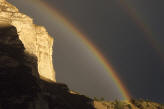|
|
Like many of the park's attractions, most forms of
wildlife are seldom seen. In fact, one may think that the wildlife is
restricted to the squirrels and birds that hover about. The animal
population here at Crater Lake is actually quite diverse. From summer
seasonal visitors such as the black bear, elk, and bald eagle, to the year
round residents like the pine marten, snowshoe hare, and Clark's
Nutcracker, the park serves as a sanctuary and home for these animals of
the Crater Lake ecosystem. Among the summer
mammals, the elk is one of the largest yet least viewed. A herd of about
150 bases itself near Union Peak and grazes in the meadows on the south
side of the park. Elk are most common in open areas near timber stands,
where they graze on grasses and shrubs. They stand up to five feet high at
the shoulder and can weigh up to six hundred pounds. Despite their size,
elk have an uncanny ability to move quietly and avoid detection.
One of the year round residents, the pine marten,
becomes especially active in the winter. The hunt for food keeps them on
the move and their lack of natural predators allows them to be especially
brave. The pine marten is a close relative of the short-tailed weasel, and
is distinguishable from its cousin as the marten keeps its brown coat
throughout the year. This is due in part to the lack of predators the pine
marten has during the cold, snowy months. Pine martens have adapted
themselves especially well to survive this time. Their small bodies and
large feet allow them to bound over the snow very effectively in their
hunt for food, most notably mice and other small rodents.
All animals in the park are wild and management
policies discourage animals' dependence on human food. Taming wildlife is
undesirable as it creates an environment where wildlife becomes a
sideshow. Even worse, when animals depend on humans for food, they lose
their independence. Once the seasonal visitors depart, the animals suffer
because they are no longer accustomed to finding food for themselves. All
animals in the park are wild, and as such, they may indeed bite the hand
that feeds them. Wild animals also carry diseases which can be transmitted
through simple contact. So, feeding animals is not only to protect an
animal's independence, but to protect people as well.
|

